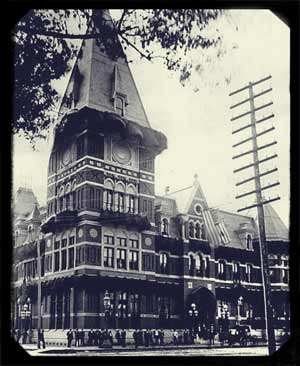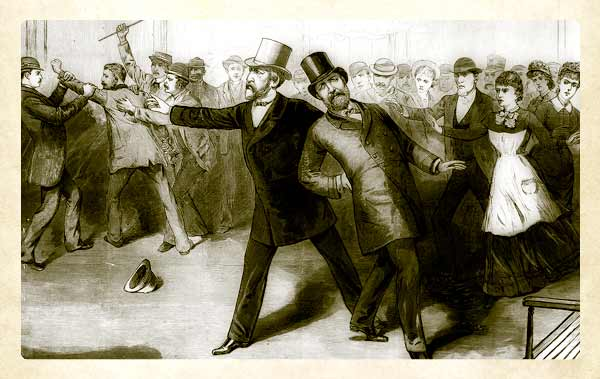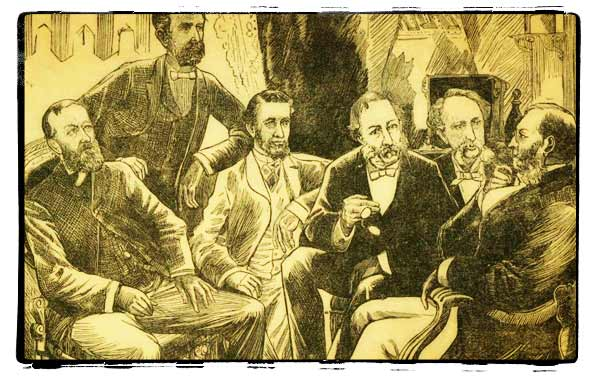Assassination of Garfield
Assassin Charles Julius Guiteau claimed that he didn't kill President Garfield-- it was the doctors, and Mr. Guiteau in his misguided sick mind was right. The doctors attending the wounded president over the weeks following the shooting were actually responsible for the conditions leading to the presidents demise.

Baltimore and Potomac Railroad Terminal after Garfield assassination.
Station is draped in black bunting and flag is at half staff.
The night before Guiteau sitting in Lafayette across the street from the White House saw Garfield leave and walk down the street to Secretary of State James Blaine's house. Guiteau immediately began to follow him, even pulling out his loaded revolver. Guiteau shadowed the president until he disappeared into Blaine's house. Guiteau patiently waited in the alley for Garfield to reappear. When the president finally exited the house, he wasn't alone. Together the president and Blaine walked back to the White House with Guiteau following close behind, revolver in hand. For some reason he didn't fire his weapon, but only walked behind close enough to pick up bits and pieces of the two men's conversation. After this night Guiteau resolved that he would not hesitate at his next opportunity, which would come in just a few hours.
It was a Saturday morning on July 2, 1881, as Guiteau paced about the Baltimore and Potomac Railroad station in Washington, D.C. His movements caught the attention of several attendants inside the station. Guiteau, mindful of the historic events about to unfold, wanted to look his best and had had his shoes shined at one of the many shine stands located at the depot. He knew there would be photographs of him being escorted away after in his words, he had removed the president from office.

President Garfield with James G. Blaine after being shot by Charles J. Guiteau
Unlike the tight security that accompanies a travelling president today, in 1881, just 16 years after the assassination of President Lincoln, there still was no security detail accompanying President Garfield. Garfield's 2 sons, Secretary of State Blaine, and Secretary of War Robert Lincoln (Abraham Lincoln's son) were the only official members of the party to see the president off for his summer vacation and rejoin Lucretia who had taken ill some months before and was spending time along the coast recuperating.
As President Garfield entered the station on that Saturday morning, Guiteau stepped forward. He raised the weapon and fired the first shot which grazed the president's right arm. Garfield cried out "My God, what is this?" and began to turn toward where the shot had come. Guiteau fired again striking the president in his back near the first lumbar vertebra but missing the spinal cord. Garfield collapsed on the dirty depot floor. For a moment the room was still and then it erupted in screams. beginning a never ending series of events that would ultimately cost the president his life.
After firing the two shots, Guiteau quickly scrambled towards the nearest exit, but before he could reach the door, those standing nearby realized what had happened and blocked his retreat. He then darted to the next exit, but was quickly subdued. A mob quickly began to form around Guiteau and threatened to lynch him. Police quickly took control and escorted the assassin back to the police station.
Dr. Doctor Willard Bliss, circa 1865)
Doctor in Charge
After the shooting, the president was taken to one of the rooms upstairs at the train station. Initial examination was made and they found one bullet had struck him in the arm, but another had struck him in the back. In trying to find the bullet on the spot, one of the administering doctors stuck his finger in Garfield's back, probing for the bullet, thus beginning a series of events that would ultimately kill Garfield.
The second bullet had struck Garfield in his back 4 inches to the right of his spine. From the point of entry the bullet continued on and came to rest just behind his pancreas. Remarkably, the bullet missed all the major organs, his spine, and just grazed an artery. He did suffer a couple of broken ribs. All-in-all the wound would not prove fatal, but at the time those that would examine Garfield did not believe he would survive the night.
Garfield was taken back to the White House. Surprisingly the next morning he was alert and seemed to be improving. It was then determined that since he survived, perhaps if they could locate and remove the bullet, Garfield may indeed survive the attack.
Robert Todd Lincoln requested that Dr. Doctor Willard Bliss, a specialist in ballistic trauma be summoned to examine the president's wound. After examining Garfield's wound with his finger and metal probes he concluded that the bullet must be in his liver. Bliss then took over administering to all the care that Garfield would receive. He requisitioned wives of cabinet members to help, even though they had no experience. Alexander Graham Bell, who had just years before invented the telephone, was also summoned to the White House. Bell, besides inventing the telephone, had also invented a type of metal detector. Doctor Bliss thought that perhaps Bell's new invention might be able to locate the bullet.
Feeling confident of his diagnosis of where the bullet was located, Bliss instructed where Bell should use his instrument and only there. Because the president was now lying on a metal spring bed (a relatively new development) Bell's machine could not locate the bullet. This was also because the bullet was on the opposite side from where Bliss had decided it was located (later determined through Garfield's autopsy).

LEFT TO RIGHT: Dr. Woodward, Dr. Hamilton, Dr. Reyburn, Dr. Barnes, Dr. Agnew, Dr. Bliss discuss Garfield's condition.
From the time of the shooting till the time of his death, some 12 doctors poked and prodded Garfield's wounds. Although in much of Europe the idea of bacteria and the infections that can come from bacteria, was accepted medical knowledge, in the United States, the medical professional rejected this notion and ignored the precautions recommended to prevent bacterial infections.
In early September, Garfield was moved from the sweltering heat of Washington D.C. to Jersey Shore in hopes that the cooler temperatures might be beneficial. On September 19, the 49 year old president died from blood poisoning and infection. He had gone from over 200 pounds to just 135.
Although Guiteau was responsible for pulling the trigger, it would ultimately be the doctors who killed Garfield from their arrogance and distrust of modern day science. Guiteau was found guilty and executed less than a year later.
Aftermath of the Assassination
It being just 16 years after the assassination of President Lincoln, we might suppose that presidential security would have been addressed. Regrettably, it was not. That issue would not be address until some 20 years later, after the assassination of another Ohio president, William McKinley.
One of the reasons for Guiteau's rage against the president was because he was not given a government job. That issue was addressed with the creation of the Civil Service Reform Act. The Pendleton Act of 1883 established a new system for assigning federal jobs. Today, the Civil Service Commission continues to place people in these jobs based on merit, rather than through political favors.
One of the most lasting results of Garfield's assassination came in an unsuspecting manner. Over the last 16 years the United States had been trying to cope with the aftermath of the Civil War. Although the war had been lost by the Confederate forces, the peace had not been truly accepted. Much distrust remained until Garfield's assassination. It was this one event that brought the country together to mourn the loss of our president. From this moment in history, the United States became one, perhaps for the first time since its founding.



